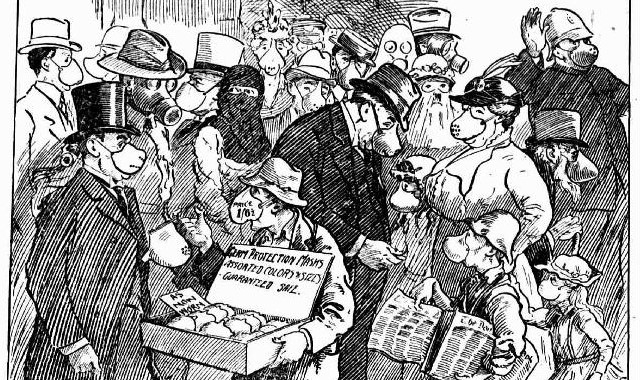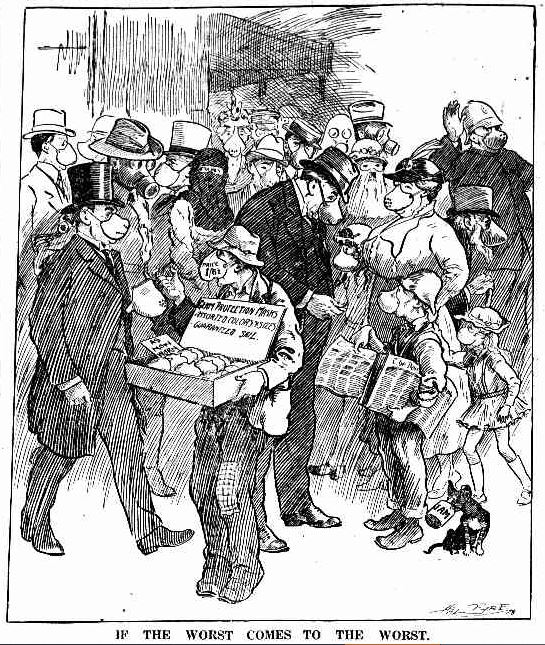With long lockdowns to look forward to there’s always a temptation to ask how we can possibly deal with an unprecedented situation.
However the Australian press from 100 years ago contains many parallels from the last big pandemic which somehow makes things seem a little less daunting: gripes about health restrictions, misinformation, interstate recriminations, sceptics, quack cures, and even social media influencers are all there.
Vaccines
“The point is emphasised that vaccination in the case of Spanish influenza is not nearly so severe as in the case of smallpox, as organisms in the vaccine used in the latter case were alive, whereas in that used for Spanish influenza they are dead.
It is stated by the Director-General of Health (Dr. Paton) that the complete immunity afforded by vaccination against smallpox cannot be promised in the case of the present disease. The belief is, however, that vaccination in the present case will afford a certain amount of immunity and lessen complications. The State laboratory is still engaged in the production of vaccine, a fairly large quantity of which has now been distributed.”
The Sydney Morning Herald November 29th, 1918
Lockdown and contacting health authorities
“The theatres will not be closed tonight, but all theatres, picture shows, and places of indoor public resort will be closed as from tomorrow till further notice in the metropolitan area only. The schools in the metropolitan area will not be reopened to-morrow.” …
The Health Department has prepared a number of S.O.S. cards, following the New Zealand example; and if there should be an outbreak in any suburb cards will be sent out, and will be distributed to the residents, any of whom if stricken can place the card in their window.”
The Sun Jan 27th 1919
Masks in school and remote learning
“Early in 1919 the worldwide influenza epidemic, which was fatal for many, many people, hit Australia. We used to go to school wearing gauze masks, and on arrival at school congregated in classrooms and were subjected to atomiser spraying of eucalyptus oil, or something of the sort. Later the epidemic became so serious that the school closed down and we were sent correspondence lessons.”
My grandfather (my kids coincidentally now at the same school)
Health passports
“Travellers by boat or train must now obtain a medical certificate that they are not suffering from pneumonic-influenza before they are allowed to proceed on their journey, in addition to signing a declaration that they have not come into contact with an infected person, have been inoculated and passed through an inhalation-chamber.”
The Sun April 13th, 1919
Interstate recriminations
“Had even the outbreak of a few months ago in New South Wales been properly investigated it is more than likely that the authorities would now be in a position to handle the present situation with the confidence and knowledge that are so lamentably lacking… The authorities in New South Wales were probably blissfully ignorant of any epidemic because influenza was not a ‘notifiable’ disease. Until a proper official form is duly filled in and posted to some individual behind a desk the public health authorities cannot take cognisance of anything. Our alert authorities in Victoria were ‘vaguely’ aware of something that was happening in New South Wales, but, not having been duly ‘notified’ on official forms, had nothing to do with the matter.”
Freeman’s Journal February 6th, 1919
Dubious cures and mask pushback
“Doctor Charles Duncan, at a convention of the American Medical Association, reported a cure for influenza. He said one drachm of infected mucus pasteurized in filtered water, if injected subcutaneously, would effect a spontaneous cure of Spanish influenza or pneumonic catarrh.”
The Grafton Argus and Clarence River General Advertiser June 20th, 1919
“The noted Swedish physician, Professor Bjorson, claims that Spanish influenza can be cured by exposing the patient’s back to a strong electric heat and light appliance, followed by the application of heat compresses, by which an intense perspiration is induced. ….
Hugh Manning, 38, carpenter, John Thompson, 38, wood and coal merchant, and George McLean, 61, seaman, were, at the Central Police Court this morning, charged with not having worn masks while they were in the public streets. …
It was stated in evidence that defendant ‘[James Lamb] took off his mask while on the way to the police station saying he would not wear it. … The evidence of the guard of the tram was that on Saturday afternoon he noticed defendant [Mr Munter] sitting in a smoking compartment with his mask off and smoking a cigarette. Sergeant Surridge stated that when he told the defendant he would have to come to the police station he said “All you people in New South Wales are mad””
The Sun February 10th, 1919
Vaccine scepticism
“There has been ample opportunity of studying influenza in South Africa. It swept through the white and colored population there like a blizzard through a field of corn.
A Royal Commission was appointed to investigate the epidemic. It came to the conclusion that evidence regarding the utility of vaccines was so controversial that it was impossible for the Commission to make definite recommendations.
All the Commission would say was that the vaccines, when properly used, caused no ill-effects — which might be said with equal truth of an injection of cold water. So dubious, indeed, was the South African Commission about the merit of vaccines that the report strongly deprecated any recommendation by the Government regarding the use of vaccines, the utility, or at least the harmlessness of which had not been thoroughly and successfully established. Much the same attitude has been taken in America with regard to the experience of inoculation in that country.”
The Mirror April 13th, 1919
‘Cure is worse than the disease’ proponents
“The business community and the working population are both enduring severe loss because of the restrictions enforced. If the disease must take its course, of what avail to prohibit race meetings, close theatres and picture shows, public schools and churches, and, by that action, create the very panic it is most desirable to avoid?
The disease, we are told, must exhaust itself. Really effective precaution is impossible, because we must live and the business of the world must go on. Most of the vexatious regulations which Sydney now endures have been tried elsewhere and proved an absolute failure. If that be so why make life a martyrdom in the vain hope of evading an enemy who, no matter what we do, must take his toll?”
The Sun April 13th, 1919
‘We need a proper investigation of the origins of the pandemic’
“It was strongly urged that some authority should make an exhaustive bacteriological examination and settle once and for all the relationship between the common influenza colds and the serious form which recurs after certain periods of years. ‘Up to date,’ says the medical officer of the Nestor, ‘this apparently has not been done. We are still in the dark absolutely as to the factors which make the cause, especially if it is of this slight original character, so virulent.
We do not even know for certain whether the two are actually connected, and yet all are lumped together under the term influenza. It is now called ‘Spanish’; it was then called ‘Russian,’ ‘Chinese,’ simply because of the place in which it first showed itself in virulent form.’”
Freeman’s Journal February 6th, 1919
Influencer pandemic stories
“The diva laughed merrily, and acknowledged that she felt stronger than when she sailed away in January, 1919, and that the dangerous attack of Spanish influenza at Monte Carlo had left no weakness behind it.
“My illness at Monte Carlo was exceedingly serious, and my life was only saved under Providence by the skill of the physicians who came from London to attend me. Yet on my recovery I sang several times in opera at the Casino Theatre, and was assured by the Press critics that I revived the happiest recollections at the same house of my predecessors in the world of song Adelina Patti and Christine Nilsson.””
Dame Nellie Melba, quoted in the Sydney Morning Herald August 4th, 1921
How long will it last?
“Maximum of 30 Days
To what extent this will affect the duration of the present epidemic it Is impossible to say. But the history of Spanish influenza, or pneumonic influenza, In other countries has been almost identical with that of influenza In Its older manifestations. In Munich, where the 1890 epidemic affected 45 per cent of the population, the records show that it took exactly 30 days to reach its maximum virulence and 30 more days to return to normal.”
Daily Telegraph February 15th, 1919
How long it actually lasted
“In his report on the outbreak, Dr Armstrong stated that on October 25, 1918, a vessel arrived In Sydney from New Zealand with cases of influenza on board, and shortly afterwards other infected ships reached Sydney. The quarantine authorities warned off the introduction of the disease during the following three months, as It was not until January 23, 1919, that the first case occurred on shore.
The invasion of Australia first took place through Victoria, from which it spread throughout the continent. The toll of life taken by the epidemic In New South Wales was extremely large, there being 6244 deaths [NSW population 1.9m in 1919]. The actual mortality rate was not extremely high, added Dr Armstrong, in the metropolitan area approximately 290,000 cases occurred, or 36.6 per cent, of the whole population, while the total number of deaths In the same area was 3002, or 1.3 per cent of those attacked.
In New South Wales the epidemic developed In two waves, the first of which reached its height in the middle of April, and was the most severe in type, but as it affected fewer people than the second wave, it was not accompanied by so many deaths. The peak of the second wave was attained about June 20 or June 21, and the epidemic finally came to an end in the closing days of September.
The incidence of the two waves in New South Wales may be followed by the rise and fall of the number of admissions to the metropolitan hospitals during various weeks. During the week ended February 1, 1919, the number of admissions was 23, and the total Increased to 1025 during the week ended April 12. The number of admissions decreased to 344 during the week ended May 24, but gradually increased again from week to week until the number reached 1315 during the week ended June 21. From that date the number of admissions decreased each week, until during the week ended September 27 there were only 20 cases, and during the three last days of September only two influenza patients were admitted to hospital.”
Sydney Morning Herald, January 27th, 1927
It’s clearly different today versus 1919: better contact tracking, vaccines, instant communication and better hospitals to name a few positive factors – along with a few increased negatives like a population with vastly greater mobility (assisting spread).
But the 6,244 NSW fatalities quoted above, as a proportion of the NSW population of 1.9m in 1919, would equate to 27,000 deaths in NSW’s 8.1m population today – vastly greater than the <3k deaths we’ve actually seen in NSW so far – and 1919’s deaths were concentrated in the 20-40 year old demographic.
Difficult as things look today, of these two pandemics today’s would definitely be the one to live through.





